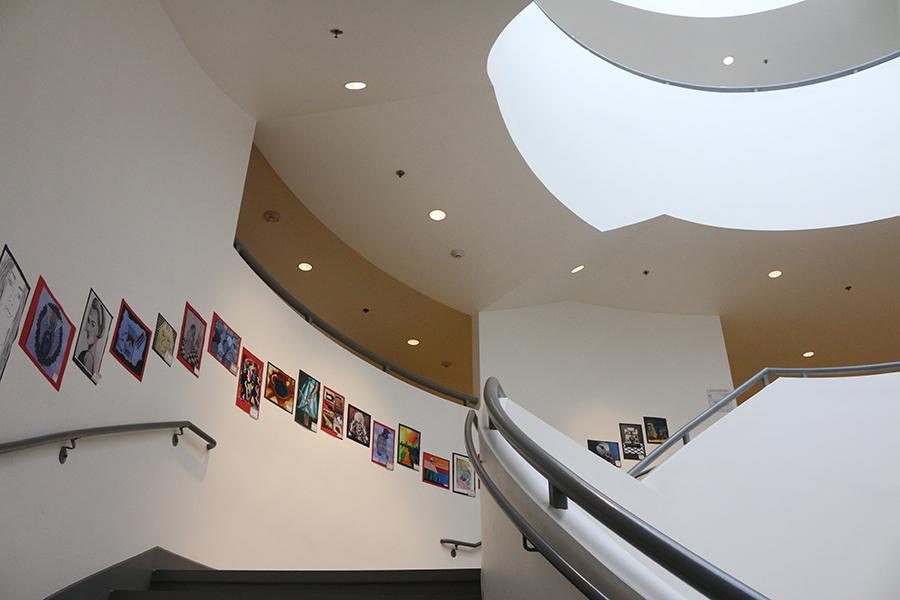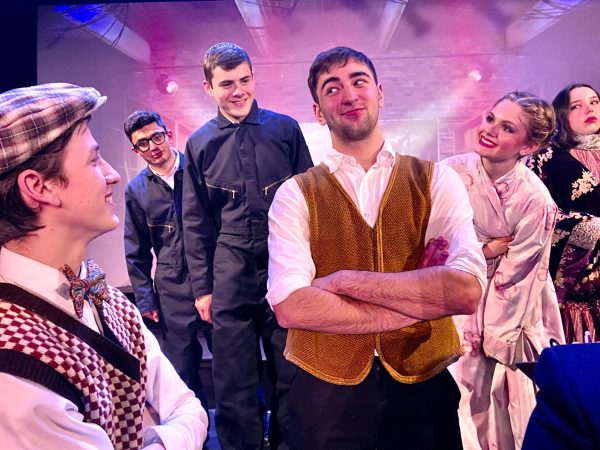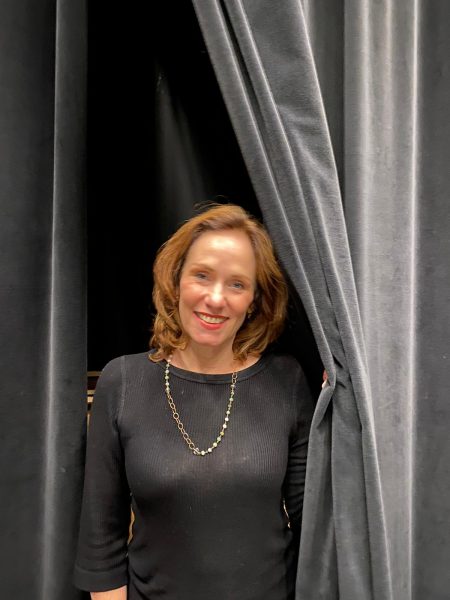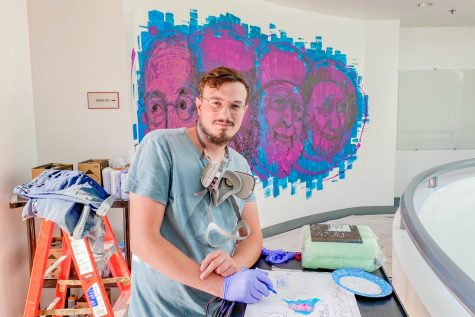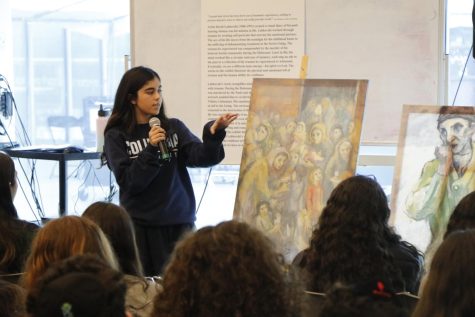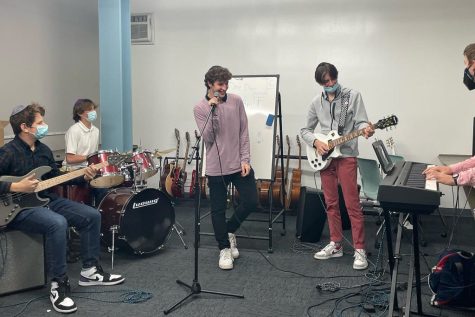In Shalhevet’s lobby, a Guggenheim of the West
Student artwork added last month to stairway walls makes lobby into a museum
There are 65 pieces of student art work up against the walls.
Shalhevet has an East Coast twin. Not SAR, Frisch Academy, or other leading Modern Orthodox high schools in New York, but rather the Solomon R. Guggenheim Museum on Fifth Avenue in Manhattan.
Though the bicoastal counterparts are not externally identical, they share internal DNA. Both feature whitewashed cylindrical lobbies with circular stairwells overlooking a foyer below. Both lobbies have glass ceilings with geometric panes, pouring sunlight into what would otherwise be a windowless space.
And since early March, Shalhevet’s ascending hallways have — like the Guggenheim’s — been splashed with brightly colored works of art, in this case art by current students.
The result is that was once a soaring but minimalistic aesthetic is now a buoyant presence created by what is essentially Shalhevet’s very own school art museum.
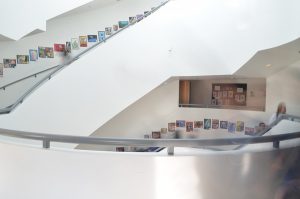
Similar to the Guggenheim’s staircase, Shalhevet’s staircase features white walls and circular stairways that overlooks a foyer below.
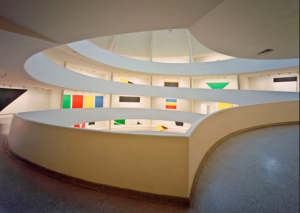
FAMILIAR: An exhibit of paintings by Ellsworth Kelly along the ascending circular ramps of the Guggenheim Museum in New York in 1997.
Many familiar with the Guggenheim — with its iconic spiral exterior, one of the most distinctive landmarks in Manhattan — had noticed the resemblance between the museum and Shalhevet’s foyer from the moment they walked in the building last summer.
One was Dean of Students Mr. Jason Feld, previously an art gallery owner in Jerusalem.
“Early on in the year I made a reference — ‘Oh this is kind of a high school version of the Guggenheim,’” Mr. Feld said.
Their circular galleries are not the only architectural gene the Guggenheim and Shalhevet share. Shalhevet’s Magen David skylight entrance tops the school’s spiral staircase. At the Guggenheim, an intricate geometric design tops a skylight ceiling with ovular shapes evenly intersecting a circular cobwebbed oculus.
To the left of both buildings’ rotundas is an elevator that takes people up to a rooftop with a coveted view. The Guggenheim overlooks Central Park, while Shalhevet surveys the Hollywood Hills, La Brea Park and Little Ethiopia, with the Griffith Park Observatory and Downtown Los Angeles in the distance.
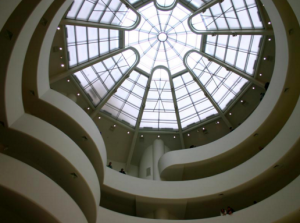
A spider’s web design divides the light streaming in from the roof of the circular seven-story Guggenheim Museum in New York.
Their circular, ascending galleries are not the only architectural gene the Guggenheim and Shalhevet share. Shalhevet’s Magen David skylight entrance tops the school’s spiral staircase. At the Guggenheim, an intricate geometric design tops the skylight ceiling of the museum’s entrance, with ovular shapes evenly intersecting a circular cobwebbed oculus.
Beneath the museum’s glass eye, a spiraling ramp descends to the lobby from an annex on the seventh floor, while Shalhevet’s spiral staircase descends from the third floor.
To the left of both buildings’ rotundas is an elevator that takes people up to a rooftop with a coveted view. The Guggenheim overlooks Central Park, while Shalhevet surveys the Hollywood Hills, La Brea Park and Little Ethiopia, with the Griffith Park Observatory and Downtown Los Angeles in the distance.
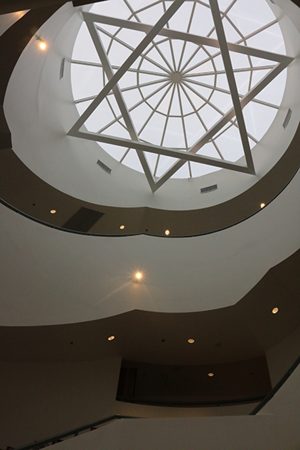
The Magen David skylight entrance on Shalhevet’s ceiling resembles the Guggenheim’s ceiling, which has its own intricate, geometric design.
But what was missing was the art. Now, 65 works, created by students in the AP Art and 10th-grade Composition and Design classes, ascend with the staircase from the entryway up to the third floor.
They range in style from Abstract to Impressionist to Post-Impressionist to early Contemporary and Modern. These are also the categories found in the Guggenheim, which was designed by Frank Lloyd Wright and opened in 1959.
The Guggenheim displays works by eminent household names such as Kandinsky, Mondrian, Braque and Cezanne. Shalhevet’s art museum has its’ own school-hold names — from AP Art, among them Lindsey Schacht, Aviva Paskowitz, Sam Bernstein and Gabe Silverstein.
Ms. Salem said she was inspired to hang up the art because of something the school’s founder, Dr. Jerry Friedman, said to her before the new building’s formal dedication March 6.
“Jerry Friedman always supported the arts,” said Ms. Salem in an interview later, “and he said it would be a night of the arts, so I put two and two together and color-Xeroxed kids’ artwork.”
Students also love having their work on exhibit.
“When the paintings were put on display, it made me feel amazing because it shows other people share a common ground—art,” said sophomore Jessica Dawoody, who takes Composition and Design.
Jessica’s acrylic painting of a little girl in a blue dress holding large red tree trimmers hangs between the first and second floor. Titled Blue Dress, it is taped a watercolor of an old man with a cane, created by sophomore Ben Mashiach, and a sci-fi acrylic by senior Daniel Shoham.
As in a museum, each student photocopy is captioned with the name and grade of the artist. Some include the title of the work, and a quotation from the artist about his or her piece.
Red Octobers, a painting of Nike sneakers by AP Art student Aron Cohen, is captioned, “I am a sneaker head and love drawing shoes.”
Adjacent to that painting is an inked abstraction by junior Yael Marcus, also of the AP Art class. A heavy amount of ink was used to draw the right side of a woman’s face, and using what she described as a “straw-blowing technique,” Yael created branches on the woman’s profile.
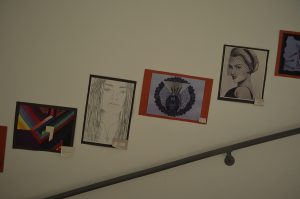
Executive Director Robyn Lewis said she plans on making original student art a permanent feature of Shalhevet’s interior design.
“If AP students are willing to donate their art, I’d like to get them framed because they’re so beautiful,” Ms. Lewis said.
For now, though, Ms. Salem said the paintings hanging are photocopies, not originals, because hanging originals would mean putting holes in the walls. She hopes to institute a new system where pieces hang from the ceiling by strings of cable.
This, she said, would truly pay homage to the Guggenheim with “moving kinetic shows,” which are ever-changing exhibits.
“Photography, paintings on canvas, featuring local artists, maybe exhibits of Jewish art,” Roen listed as examples of possible shows.
Mr. Feld is already pleased with the results.
“I love seeing the art on the walls.” said Mr. Feld. “Setting aside the aesthetic of the round [entrance] and the skylight, the more student art we have on the walls, the happier I am. It’s a better reflection of the values of Shalhevet.”

Hannah Jannol was Editor-in-Chief of the Boiling Point during the 2017-2018 school year. Since then, she has attended The New School and written for their HerCampus chapter; edited obituaries for The Trace; written poetry for Eleven and a Half literary magazine, and run Instagram and Twitter for Uptown Stories. Her favorite parts of being on Boiling Point were production night and writing long-form features stories, many of which won awards from CSPA, Quill & Scroll and the American Jewish Press Association.

